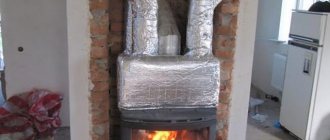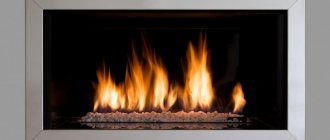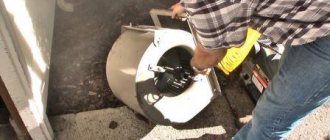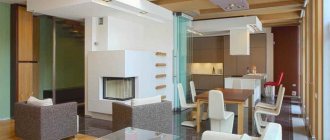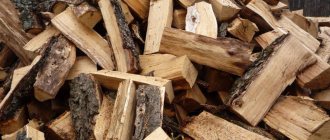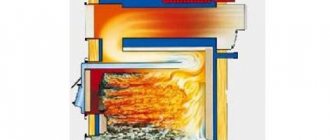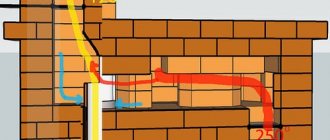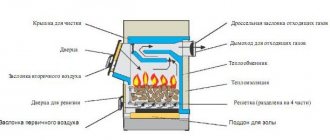A short historical excursion
Initially, a “potbelly stove” was a name given to a steel stove of a certain design, the creation of which took place during the dramatic years of the Civil War for our country. It is not known exactly which of the Russian engineers came up with a very simple, but very effective steel furnace, relatively easily made in a handicraft way from more or less available materials. During the times of “war communism”, after the urban economy with centralized heating in large cities collapsed, this tiny stove, which could be installed almost anywhere in a “bourgeois” apartment densely packed with house committees, saved many lives. By the way, the statement that the stove got its name due to excessive consumption of firewood is a stupid legend born on the Internet. In fact, the potbelly stove is very economical for its type. In conditions of a severe shortage of coal and firewood, the owner of a walnut set by master Gumbs had the opportunity to survive a terrible winter, using the precious furniture as firewood. The name of the furnace was determined by the fact that at first it became widespread among “former” engineers, office workers, and intellectuals who did not emigrate from the country. That is, according to the concepts of the proletariat, “bourgeois”.
Type of fuel
Most fireplace stoves are designed to use wood. The type of firewood does not matter much - coniferous or deciduous, it is not so important. It is important that the firewood is dry. For this purpose, many models have a shelf for storing firewood. After lighting the fireplace, a new portion is placed on the shelf, which dries at an accelerated pace, since the temperature is higher.
When choosing a metal or cast iron fireplace stove, pay attention to the type of fuel for which the unit is intended
There are metal fireplaces that can be burned with coal. This type of fuel provides more heat with less consumption. But when burning coal, the temperature in the firebox is much higher than when burning wood. Therefore, it is not recommended to heat a wood-burning stove-fireplace with coal. No, you can add coal and it will burn well. But after a short period of time, the fireplace insert will burn out. This will happen due to the fact that the combustion temperature was much higher than “planned”. If you plan to periodically use coal, you need to look for a long-burning stove-fireplace for a summer house or home, whose characteristics indicate the ability to burn with coal (black or brown also makes a difference).
Wood-burning stove-fireplace Moscow 12 (manufacturer Meta)
Okhta fireplace stove for wood and brown coal
A budget option for a cast iron stove-fireplace for coal - Torn (Torn) manufacturer Eurokom
French stove fireplace for pellets and wood INVICTA MIX
Pellet stove fireplace NOLA 7 Invicta (made in France Invicta)
Beautiful cast iron stoves and fireplaces for pellets Castelmonte
When choosing pellet stoves, pay attention to the size of the loading box
The famous heating stove Professor Butakov from Termofor can be equipped with a fireplace door
You can also heat a metal fireplace stove with fuel briquettes of various types; there are those that can run on fuel granules (pellets). In general, when choosing, pay attention to the type of fuel used. It is important.
The design and principle of operation of a potbelly stove
The efficiency of a potbelly stove is largely determined by an accurate calculation of the ratio of the volume of the firebox to the diameter of the chimney.
The pipe is made slightly narrower (in moderation, otherwise smoke will pour into the room), because of this, a significant part of the gases is not drawn out immediately, but first makes several revolutions inside the firebox. This promotes more complete combustion of fuel. When calculating, the following proportion is used: the diameter of the chimney in mm should be 2.7 times the volume of the firebox, measured in liters. Today, the term “potbelly stove” is used by everyone. Often this is what all steel furnaces are called. But we believe that only those stoves that have inherited the main design features and properties of the prototype are worthy of bearing the proud name “potbelly stove”. In the modern version, the potbelly stove often has a horizontal design, this is more convenient for laying full-size firewood about 40 cm long, and is also equipped with a blower and grate, which makes it easier and more accurate to regulate the air flow and fuel burning rate.
Advantages of a fireplace stove in a country house
Unlike a traditional fireplace, it has a number of advantages:
- quickly heats the room;
- the room warm for a long time
- independence from electricity;
- possibility to choose the type of fuel;
- the design is absolutely safe ;
- air masses circulate well in the firebox;
- the fireplace will fit well into the design of a country house;
- a wide range of fireplaces on the modern market.
Where is the best place to install a stove in a garden house?
From a planning point of view, the stove is installed based on the placement of rooms (if any) and the arrangement of furniture. But there is also a technical aspect that affects the location of the furnace. The fact is that according to existing standards, in order to create sufficient draft, the height of the chimney from the grate to the top on the roof must be at least 5 meters. Garden houses are low, and if there is a mansard roof, it often has a significant slope. Based on the above, we can conclude that the best place for a stove in the house is closer to the ridge, the highest place on the roof. Ideally - in the center of the ridge. This placement makes it possible to place almost the entire chimney inside the house. As a result, the heat from the chimney heats the attic, and the draft is stable due to the fact that the chimney is not cooled from the outside.
In accordance with this scheme, the height of the chimney head is determined depending on its distance from the ridge and the slope of the roof. Another reason to place the stove closer to the ridge.
Fireplace stove design
The fireplace stove system is quite complex; each element has its own characteristics that are clearly different from each other. The fireplace has a large open firebox, this allows you to create a large air draft, which means the fire will quickly flare up and warm the room. And in order to remove combustion products without delay, the fireplace has a straight exhaust pipe. But as soon as the flame goes out, the heat stops flowing into the house. The oven has a completely different principle of operation. It does not require a large firebox and strong draft, so the fuel does not burn, but rather smolders, gradually heating the stove. The heat accumulates and warms the house for a very long time, even without fire in the firebox. And the winding exhaust pipe only contributes to this, trapping hot gases.
The stove makers managed to combine the stove and fireplace together. You can’t heat all the fireboxes at once, but if there is a need for this, you should light the fireplace and then the stove. Since the fireplace has a more powerful air draft.
Installation of a stove-stove in a garden house
When installing a potbelly stove, fire safety regulations must be strictly observed, because the body of a steel stove and an uninsulated chimney heats up very noticeably. First of all, it is necessary to ensure minimum distances from the stove elements to the combustible structures of the garden house. If the stove is factory-made, these requirements will be indicated in the instructions, but in any case they should not be lower than those prescribed by the standards:
Protective screens are indicated in red. The screen located near the stove should not be located close to the body. It is necessary to leave an air gap of 3-5 cm to prevent overheating and unimpeded heat transfer into the room
Most modern incarnations of the factory-made potbelly stove are equipped with protective screens with a ventilated gap.
As you can see, if you have a screen made of heat-resistant materials, the potbelly stove can be moved closer to the walls, which will save space in the house. The recommended screen design is asbestos cardboard no thinner than 10 mm, covered with a metal sheet with a thickness of 0.55 mm. Today, ready-made aesthetic screens made of rigid mineral wool board or basalt cardboard and stainless steel are more often used.
Fireproof cutting of the chimney is carried out when it passes through the ceiling and roof. The empty or filled with stone wool space between the pipe and wooden structures is covered with a steel apron
Our readers often ask: “Is it worth covering a potbelly stove with bricks? We answer: under no circumstances. Taking into account the design features, this can lead to overheating and burnout of the chimney. We can only talk about a ventilated protective casing for the side and rear surfaces. If there is a desire to significantly increase the heat capacity and slightly heat transfer of a steel stove, it can actually be connected to a brick heating panel. True, only if there is sufficient traction and space for a relatively bulky brick structure.
A massive heating shield utilizes part of the heat from the exhaust flue gases and accumulates it.
In conclusion, we note that installing a stove and installing a chimney in a house require professionalism and high responsibility. You should undertake such work with your own hands only if you are completely confident in your abilities. Otherwise, it is better to entrust the work to experienced craftsmen who are well versed in fire safety regulations.
Furnace installation
- The furnace is being installed on the prepared site. The equipment comes with documentation and necessary parts for installation. The main difficulty is the phased formation of the chimney:
- The direction of the pipe can be horizontal or vertical. The exit is through the wall or ceiling.
- Double-walled pipes are used, between which basalt wool must be laid. The chimney pipe system is being assembled and the location of the hole in the wall or ceiling is calculated.
- A chimney pipe is mounted to the top of the housing.
- To adjust the draft, a gate is installed.
- If the pipe is located at an angle, a half-bend is used.
- A sheet of metal is attached to the ceiling. A hole is made in it equal to the diameter of the pipe.
- A chimney is passed through it, and basalt wool is inserted into the free space (from the sides).
- If the chimney outlet is planned to be in the wall, then a tee is attached to the outside. A vertical pipe is inserted into it and it is fixed with clamps to the wall of the house. A deflector is mounted below to collect debris.
Varieties
- Wood stoves are divided into two main groups:
- brick;
- metal.
The main feature of wood-burning brick stoves is the ability to accumulate and gradually release thermal energy. The greater the mass of actively heating brick, the longer it will take to heat up, and the longer it will take to cool down after the wood has stopped burning. A properly built brick oven remains warm for at least a day.
Metal stoves can warm up a small room in 40-60 minutes from minus temperatures to +20ºС. But they cannot store heat - metal has good thermal conductivity, due to which it heats up quickly and cools down quickly. This means that the stove heated in the evening will take on the ambient temperature by morning.
Which stove model to choose, brick or metal, depends on the requirements for it. For people living in the country during the summer season, brick is more profitable and convenient. If trips to the country are relatively rare, and upon arrival you need to quickly warm up the house, it is better to choose a metal model with a long-burning mode.
Brick
It is difficult to describe all the variety of brick heating stoves, so it is worth considering only the most common ones.
Russian stove
This is the heart of any original Russian hut - it not only effectively heats the house, but also allows you to cook food, dry clothes and shoes, and you can place a warm bed or bed on top of the stove.
But such a stove is not suitable for a summer cottage for several reasons:
- Maximum efficiency is achieved only with a constant fire and during long-term burning of the fire, when the temperature fluctuations of the brick are insignificant. In an unheated house, a Russian stove absorbs moisture during the winter, and in the spring it is difficult to heat it; moreover, heating a damp brick leads to its cracking, and the stove begins to collapse.
- It takes up quite a lot of space and requires a capital foundation for its massive structure. Not every country house can accommodate a Russian stove.
- Laying a Russian stove requires certain skills; it is difficult for a beginner to build it with their own hands, so you will have to seek the help of a professional stove maker.
Dutch
Heating or combined duct stove, shaped like a square or rectangular column. In the original, it was intended only for heating, and thanks to its shape it can simultaneously heat several rooms. But the country version of the “Dutch” is sometimes made with a hob, which slightly increases its dimensions but improves functionality.
Advantages of the "Dutch":
- has a relatively compact size;
- keeps warm for a long time;
- simple design, you can fold the “Dutch” with your own hands.
Minuses:
- The Dutch woman is demanding about the quality of firewood;
- warms up slowly after a long break, especially at sub-zero temperatures outside;
- it is necessary to monitor the stove and close the view in time: if you close it too early, carbon monoxide may be released, if too late, all the heat will “blow out” to the street.
You can’t close the stove before the last firebrands have burned out! The coals should glow with an even red light without the slightest sign of blue flame!
Swedish
"Swedish" is a universal stove suitable for long-term use. It has not only a hob, but also an oven, and well-heated niches designed for drying clothes and shoes.
The oven is located next to the firebox, one of its walls is separated from the firebox by a thin sheet of iron, due to which, immediately after the wood starts burning, the oven warms up perfectly and begins to radiate heat into the room.
The hob is made of cast iron and is located in a niche directly above the firebox. Above it there is another niche - a stove. The heat from the hob heats the base of the niche, making it quickly warm and dry.
The smoke channel from the firebox is directed downward, as a result, hot flue gases heat the base of the stove and the floor. Channels can be located both vertically and horizontally. Sometimes a heat exchanger for hot water is built into them.
Advantages of the “Swedish”:
- rapid heating of the room from the oven and hob even at the beginning of the wood burning;
- a well-heated stove retains heat for a long time;
- You can dry wet shoes and clothes on it;
- the hob and oven allow you to prepare any dishes;
- the dimensions of the furnace are slightly larger than the “Dutch” furnace with greater efficiency;
- Having a detailed description and ordering diagram, you can fold the “Swede” with your own hands.
Minuses:
- “Swedish” requires lining the firebox and channels with fireclay bricks; it is more expensive than ceramic;
- For effective heat transfer you need good dry firewood.
Thus, the most successful design of a brick stove for a summer residence is Swedish. The laying of a multifunctional stove of this type is shown in the video.
Metal
One of the main advantages of a metal stove is fast heating. If visits to the dacha are periodic and spontaneous, then the optimal and most economical option would be to install a conventional welded potbelly stove.
Advantages of a metal stove:
- simple design from available materials;
- lightweight, does not require installation on a foundation;
- you can equip a hob;
- It is not necessary to put high-quality firewood into a potbelly stove; you can heat it with branches, cardboard, or burn garbage;
- does not require the installation of a major chimney, the pipe can be routed through a wall or window while maintaining fire safety distances;
- It is mobile, in the summer it can be taken outside or into a gazebo.
Disadvantages of a potbelly stove:
- cools down quickly, by morning it will be cold in a heated house;
- The appearance of hand-made metal stoves is unlikely to be a subject of admiration.
- You can extend the burning time if you make a long-burning stove, but you should remember that its safe operation requires some skills.
Wooden house with fireplace
A stove, bathhouse or house with which is made of wood requires a special, individual approach during installation and assembly.
To its credit, fireplace stoves look most beautiful and stylish in a wooden house. However, this arrangement is not always safe.
Before you buy a fireplace stove and install it in your wooden house or country house, you need to familiarize yourself with the following safety rules:
- A frame fireplace stove should be installed only after you and a specialist have thought through and approved the installation plan;
- The metal firebox is installed only on previously prepared floor coverings and near protected walls. A metal alloy or aluminum foil is used for sealing. If the fireplace is cast iron, it is recommended to install and place it on a pre-built pedestal;
- Installation of a fireplace stove in a wooden house is carried out only after protection and creation of special partitions. To create them, steel gratings and sheets of plasterboard are used.
Leading designers recommend installing a corner, island, wall-mounted or hanging fireplace in a country cottage.
A fireplace stove, the price of which depends on the manufacturer, functionality, materials of manufacture, can be equipped with a glass fireproof door or have a completely open hearth, which is less safe from a fire point of view.
A corner fireplace, like a hanging fireplace, is more suitable for small spaces. Island and front designs are located in fairly spacious living and dining rooms. When installing a heating unit, pay attention to the fact that this structure does not fit flush against the walls of the house, as this can cause the wood to deform and lose its strength. All passages, joints and connections must be sealed with fireproof materials.
It is recommended to additionally protect the wooden surface of walls and floors with special fire-resistant impregnations, compounds or varnishes.
Design Feature
But not only high performance is the advantage of this design.
The whole point of long-term burning is that not the entire stack of firewood burns out at the same time, as happens in a classic stove, but only the top layer.
Principle of operation
This becomes possible due to air intake from above, and not from below through the ash pan. Thus, fuel combustion occurs gradually, in its upper layer. When this layer burns out, a new portion of oxygen is supplied through the regulator, and exactly as much as is needed for the combustion of the top layer. This ensures such a burning duration and the ability to control the process.
The main point in a fireplace stove is maintaining long-term combustion, during which the fuel elements completely disintegrate. As a result of this process, large volumes of hot gases are formed and a large amount of heat is steadily released.
The implementation of secondary afterburning occurs in the second chamber (upper).
In the fuel chamber, where the firewood is placed, the primary combustion of the fuel occurs. Hot smoke rises up the pipe and burns out completely. To stimulate the secondary combustion of wood, the design provides for the presence of pipes through which oxygen flows.
Today, two long-term combustion systems implemented in such devices have become widespread. These are the Canadian system Buleryan and the Baltic Stropuva. At the same time, the Burelyan system is very popular in our country due to its small dimensions and low price. But the Stropuva system is less common due to its high price and large number of technical parameters.
Traditionally, the Burelyan system (this is the technology that will be used in the long-burning stove-fireplace we are describing) is a small stove consisting of two chambers.
The main combustion of wood occurs in the lower chamber, resulting in the formation of wood gas. When heated, it rises and enters the second chamber, which is located above the first.
Scheme of a stove with a long-burning hob
Here, diffusion of hot gas with air and secondary combustion occur.
Another difference from a traditional fireplace stove is the location of the firebox door. If it is usually attached from below, then here the design will be slightly different.
The burning time itself suggests that the process will require a large amount of firewood, which must be located somewhere.
It is for this purpose that the lower chamber (or firebox) should be large, and the door through which firewood is placed should be located high enough.
Features of a long-burning stove
In a fireplace stove, the ash pan plays a purely technical role and is intended to clean the stove from residual ash, of which very little remains after double combustion of the fuel. Considering the fact that air enters through a special hole located in the upper part of the furnace, the ash pan door must be absolutely sealed.
Otherwise, there will be no question of any long-term combustion if oxygen comes from below the stove.
So, summarizing the design features of a long-burning fireplace stove, we can highlight the following points:
- large volume of combustion (loading) chamber;
- dividing the main firebox into two parts: upper and lower chambers;
- lack of blower;
- adjustable oxygen supply from above.
The higher the humidity of the wood, the lower the efficiency of the stove will be. Therefore, for combustion it is recommended to use fuel with a moisture content of no more than 20%.
Power selection
The description of a metal fireplace stove must indicate the heating area it is designed for. When choosing power, it is better to take a margin of about 15-20%. This is to prevent the body from overheating even on the coldest days. It quickly burns out in this mode.
The power of the fireplace stove is selected with a small reserve - for the coldest days
On the other hand, you shouldn't take too much stock. Solid fuel stoves and fireplaces are difficult to regulate in temperature. And, if the power of the heating equipment is many times greater than necessary, the room will be too hot when firing. Nothing can be done about it. If the power is too high, even in smoldering mode there may be too much heat.
So, when choosing the power of a long-burning fireplace stove for a summer house or home, we take it with a margin of 15-25%. For example, the heated area is 100 sq.m. A suitable metal fireplace should have the ability to heat 115-125 square meters.
Video review of the Kratki Koza K9 stove-fireplace.
Types of stoves for long-burning cottages
The main division of fireplaces-stoves intended for installation in wooden houses is the division according to the material from which they are made. Stoves can be steel or cast iron.
The design of a long-burning bell-type stove with an open oven and a surface for heating food.
Steel stoves heat up faster and release heat to the surrounding area faster, heating the room to a comfortable temperature. Therefore, it is preferable to install them in those country houses that are used occasionally and on short visits. If a country building is intended for long-term or permanent residence, including during the cold season, it is better to install a cast-iron stove in it, optimally connected to a heating system with some kind of coolant (water or air).
One of the most popular models is the “buleryan” type oven. This type of stove has an improved heat exchanger design and, provided it is equipped with a manifold and a water casing, can be used to heat several rooms. In addition, it can also serve as a stove for cooking.
The operating principle of the Buleryan stove.
